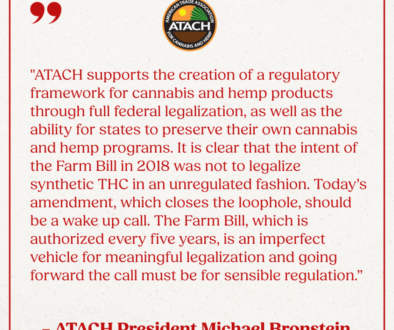Top “Threat” to Legal Cannabis? Confusion Over Intoxicating Hemp Products, Says Head of CANNRA
With the Farm Bill again up for debate this year in Congress, some regulators and industry members hope that hemp-derived cannabinoid products will be part of the discussion.
On Thursday, the Council for Federal Cannabis Regulation hosted a virtual event that focused on these products, from the more common ones containing CBD to the newer, trickier ones containing delta-8 THC, which is derived from CBD and causes a high. Speakers included Gillian Schauer, executive director of the Cannabis Regulators Association (CANNRA), Christian Sederberg, founding partner of Vicente Sederberg LLP, Kay Doyle, founder of Oui Coaching & Consulting and former Massachusetts cannabis regulator, and Michael Bronstein, president and co-founder of the American Trade Association for Cannabis & Hemp (ATACH).
Shauer said that hemp-derived products containing THC continue to pose a significant challenge for regulators, especially in the absence of clear federal guidance.
“Consumer safety is one of the biggest challenges that regulators face in this space, and trying to figure out how best to protect consumers with this new avenue through which we’re seeing cannabinoid products,” Shauer said.
The hemp-derived cannabinoid products industry boomed after Congress passed the 2018 Farm Bill, which legalized cannabis plants containing .3% THC or less, defined as hemp. However, these products exist in a legal and regulatory gray area. The U.S. Food and Drug Administration was tasked with crafting rules for these products, but concluded this year that Congress must act first. Whether they do so through the new Farm Bill, or standalone legislation, and how, remains to be seen.
All of this, Shauer said, has led to a great deal of confusion among consumers about what hemp really is, and what hemp products actually are.
“The labels are not helping them understand,” Shauer said. “I think this is the biggest threat to the regulated market experiment that we’ve seen.”
Shauer has called — more than once — for federal officials and members of Congress to step up and engage on cannabis, especially hemp-derived cannabinoid products. So far, she said, that hasn’t happened.
“There is a void of federal engagement in this space on the regulatory landscape. And state regulators need federal engagement to help with harmonization because cannabis and hemp laws are increasingly being made through state legislatures,” Shauer said. “It is not as simple as getting a group of regulators together who say, you know, this makes sense and we should all do this. Every state has to take that through their legislative process. So I think that would be a huge benefit to having more federal engagement on this, to set some minimum standards that could create that harmony.”
Doyle said that harmonization is needed in areas like testing, labeling, and consumer education, for example.
“If there’s nothing else that we’ve learned from regulating cannabis, it’s that the law of unintended consequences is very alive in this space. So, we really need to ensure that we’re taking everything into account as we do this, and I think it can be done,” Doyle said.
Shauer said she’s noticed a trend where a handful of states, including Washington, Oregon, Colorado, and Virginia, created task forces to discuss regulation of hemp-derived cannabinoids.
“They struggled with the same issues that regulators and legislatures were,” Shauer said. “I think this is an extremely challenging topic to legislate.”
“We’re lacking really clear science to help guide some of those thresholds that are being talked about legislatively. And I think in general there’s still a discussion about the fact that a serving size is likely still needed,” Shauer continued.
Shauer then asked Sederberg whether a task force is “really any more effective than the legislative debates?”
“Is there a better way?” Shauer asked. “I think it’s probably being talked about federally with the [2023] Farm Bill on the table.”
Sederberg said that part of the reason for the task forces is because of the lack of top-down guidance “at the federal level.”
“The reason why this became a task force was because it was a defensive mechanism, honestly, for folks in that industry to sort of say, ‘let’s kick the can down the road a little bit,’” Sederberg said. “That’s not taking away from their desire to get to good public policy and have more open discussions.”
The task force in Colorado, Sederberg said, conducted more than 100 hours of meetings and produced recommendations to the state legislature (read this task force’s report, published in January). Now, the legislature has roughly a month left to consider a bill that Sederberg said he expects to be introduced next week.
“This was like the biggest onion peeling exercise of all time,” Sederberg said.
Panelists were asked to consider the specific policy wrinkles raised by the effort to regulate hemp-derived cannabinoid products now that they’re already sold from coast to coast, often with little in the way of age requirements.
“I don’t think we can just say ‘the pony is out of the barn, wave goodbye.’ There has to be something done to protect public health and safety. And I think that is capable of being done,” Doyle said.
Another challenge for state regulators is having two separate regulatory bodies for cannabis and hemp.
“I would think we want to avoid that federally. We want to avoid having a regulatory pathway for hemp over here and for cannabis over here someday,” Shauer said.
Bronstein said that regulations need to move toward rules that guide the final products, how it’s marketed and labeled, who it’s intended for, and for what purposes.
“The actual regulatory confusion at the federal level is stopping not only the production of lawful intoxicants, but at the same time it’s proliferating an entirely lightly-to-unregulated marketplace,” Bronstein said.
Bronstein called for a public health approach to future federal rules that protects consumers.
“This is the biggest question of our time, relative to how we move forward on cannabis regulation and this Farm Bill, to which there will be a before and after,” Bronstein said. “Where these lines are drawn, and how regulatory infrastructure exists afterwards, is going to either create additional challenges or additional opportunities. So, we have to be very careful about how we advocate.”




